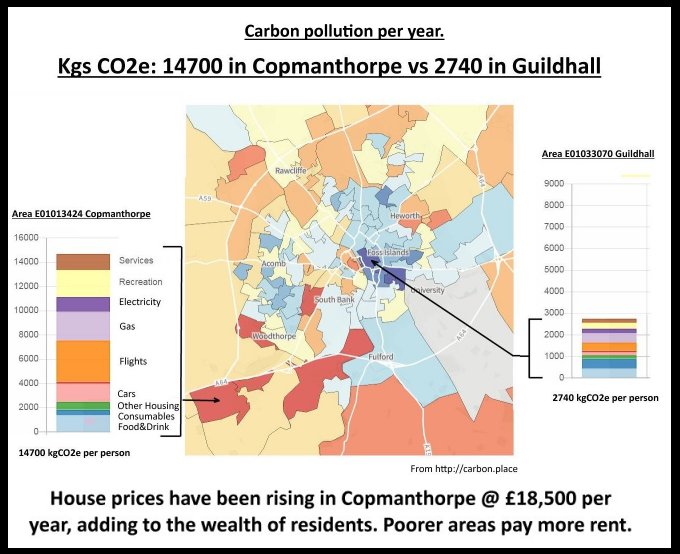Housing: Twenty years on. Plus ça change.
In 2020 …

But back in 2002 … on faxfn.org
———-
NIMBYs steal from the poor & destroy the Planet
———–
If the World were like York people we’d need three Earths
A recent report compiled by John Barratt of the Stockholm Institute for Planet York says that an average York resident has an individual green footprint of 6.91 hectares. This report gives a “fair earthshare” footprint as 2.1 hectares so if everybody on Earth lived as the residents of York, we would need three planets like Earth.
(An individual’s green footprint is the area of the Earth required to grow food, absorb waste and provide raw materials for consumption. One of the largest elements in the green footprints of the affluent world is the area of land required to absorb greenhouse gasses, particularly Carbon Dioxide from energy generated for heating and cooling buildings, transport and manufacturing products for consumption. See Pippa Langford Introduction to greenfootprints.)
The rich need more – the poor need less
Planet York’s brochure for the launch of this green footprint report shows that some individuals have bigger footprints than others. Some people are the sort that could fit on one planet Earth, others would require five or more planet Earths.
There is, of course, an obvious connection between affluence and consumption so, in general, the rich and affluent are the more polluting.
The Green Belt gives to the affluent and powerful
Property prices are rising in York at over one thousand million pounds a year. This value gives those, who already have their feet on the ladder, an enormous store of wealth, which sooner or later they will spend. Most of this is directly attributable to the manipulation of the market in planning permission by Green Belt policy.
The obvious backers of Green Belt policy are the NIMBYs who gain so much wealth through their houses and some pleasure in driving their cars through the Green Belt. But there are more powerful and well organised interests that benefit from the allocation of planning permission: land owners, property developers and, of course, the University.
Regulating the price. Distributing the spoils
It may not be York Council’s intention, but the slow release of planning permission regulates the price of development land more effectively than OPEC regulates the price of oil. The small amounts released keep the value of the NIMBYs’ assets rising. This strategy also hands enormous benefits to those organised enough to understand the system or lucky enough to be able to mask commercial development under the guise of education.
Planning and pollution
It is, of course, one of the objectives of our current planning system to regulate development in order to reduce pollution. Indeed, the Green Belt policy itself is thought of as a “green” policy. But it is clear that this is not the case because it gives wealth to people so that they can increase their consumption and so increase their pollution and green footprint.
A recent “Analysis” program on Radio 4, “Home Economics” made part of the link:
Andrew Henley, Professor of Economics, Aberystwyth University said “There is now this phenomenom of housing equity withdrawal that people, … may well be withdrawing equity to spend on other things. That may typically be to buy new consumer durables – carpets, curtains, furniture – for the next house… Some of it goes into overseas holidays and new cars.”
Martin Ellis, Group chief economist, Halifax Building Society said “People have extracted a record amount from the housing equity and that amount is at 18 billion pounds in the first 3 months of this year. That is the highest amount ever and it’s one of the reasons why consumer spending is so buoyant at the moment.”
If anyone does know of any economist (or anyone) who has done any studies on the demographics of pollution please let us know. But the main point is, of course, obvious: House owners pollute more as their assets inflate. We fly away to our holiday in the sun. We consume more fruit and vegetables flown halfway round the world and we buy bigger cars.
Stealing from the young and the poor.
The rise in house (or planning permission) values has established an enormous transfer of wealth to householders from those that buy their houses in the future.
Additionally, with the increase of “buy to let”, property owners are now benefiting from increases in the value of the “houses with land and planning permission”. It is, of course, the value of the planning permission that is rising. The benefit is in the form of increased rental values, at the expense of people in the rented sector.
The ones that loose out are typically the young and the poor and increasingly the not-so-poor as a recent report by the Joseph Rowntree Foundation has highlighted (“Land for Housing: Current Practice and Future Options”, March 2002, James Barlow).
See also Planning, Wealth Transfer And Environment.
The answers?
See Part 2 in September.
